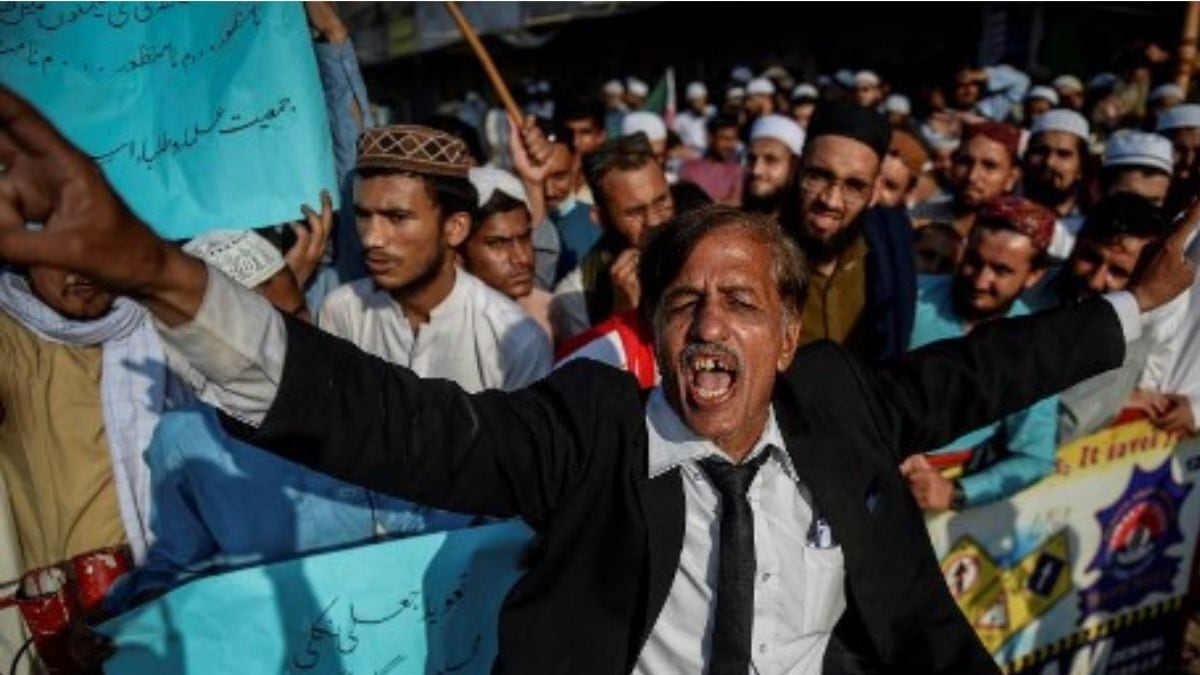
Activists from the Pakistan Democratic Movement (PDM) shout slogans as they take part in a anti-government demonstration to protest against inflation, unemployment and other economic issues in Karachi on October 22, 2021. (Credits: AFP)
The rate of unemployment in Pakistan for graduates was 16.1 percent, for engineering 23.5 percent, for agriculture 29.4 percent and for medicine 10.8 percent
Pakistan is in the middle of an economic and political crisis which seems to unfold new challenges for Islamabad with each passing day. The country faces an unprecedented crisis in the face of rising inflation, devaluating rupee and rising inflation.
A recently released study has claimed that the rate of unemployment among educated youth is 31 percent while it is higher for women at 51 percent.
The study, conducted by Henna Ahsan and Muhammad Jehangir Khan of the Pakistan Institute of Development Economics (PIDE), shows that the likelihood of unemployment in Pakistan grows with the level of education.
A cash-strapped economy, with a poor labour market and low exports, unable to accommodate a rapidly growing number of educated workers has led to a high graduate unemployment rate.
The study, using the employment data from 2001-02 to 2020-21, showed that the rate of unemployment for graduates was 16.1 percent, for engineering 23.5 percent, for agriculture 29.4 percent and for medicine 10.8 percent. The overall unemployment was 16.1 percent in 2020-21, it showed.
The study also showed that the gap between the rate of overall unemployment (6.3 percent) and that of graduates (16.1 percent) is almost 10-percentage-point wide.
“The unemployment rate for graduates increased from 14 percent to 16 percent from 2018-19 to 2020-21. However, when we decomposed the unemployment rate into sub-disciplines it produced a gloomier picture. The unemployment rate for engineers has increased from 11 percent to 23.5 percent which has doubled in just two years,” the study said.
“A similar situation has been observed for those who graduated in computer science and agriculture. The unemployment rate within the medical discipline has too drastically increased by 68 percent in just two years,” it added.
The study attributed the rising unemployment to the ‘misalignment’ between demand and supply that led to joblessness in recent graduates.
It also said that the unemployment among natural sciences graduates is increasing as the enrolment in the field is outpacing demand in the labour market.
“The gap between supply and demand is wider for graduates in natural sciences as compared to social sciences and management sciences. Therefore, to address graduate unemployment, there is a need to look at the unemployment issue by ¬eld of study in the country,” the research stated.
Noted economist Hafiz A Pasha has predicted that the number of unemployed people in Pakistan will increase by over 20-80 lakh by the end of 2022-23. He said that unemployment rate could reach 10 percent “probably for the first time”.
The distribution of unemployment could be seen across the states in Pakistan with variations in sector-wise data, according to the study. The study stated that unemployment persists in Khyber Pakhtunkhwa, Punjab, Sindh and other provinces.
“Surprisingly graduates in agriculture also suffer from high unemployment rate in Sindh and Punjab as theses provinces, despite being rich in agriculture, may not be offering ample opportunities for highly educated agriculturists,” it added.
The study comes as Pakistan reported highest year-on-year inflation at 35.37 percent in nearly five decades this month.
Years of financial mismanagement and political instability have pushed the country’s economy to the brink of collapse, exacerbated by a global energy crisis and devastating floods that submerged a third of the country last year.
The country needs billions of dollars of financing to service existing debt, while foreign exchange reserves have dwindled and the rupee is in freefall.
Read all the Latest News here




